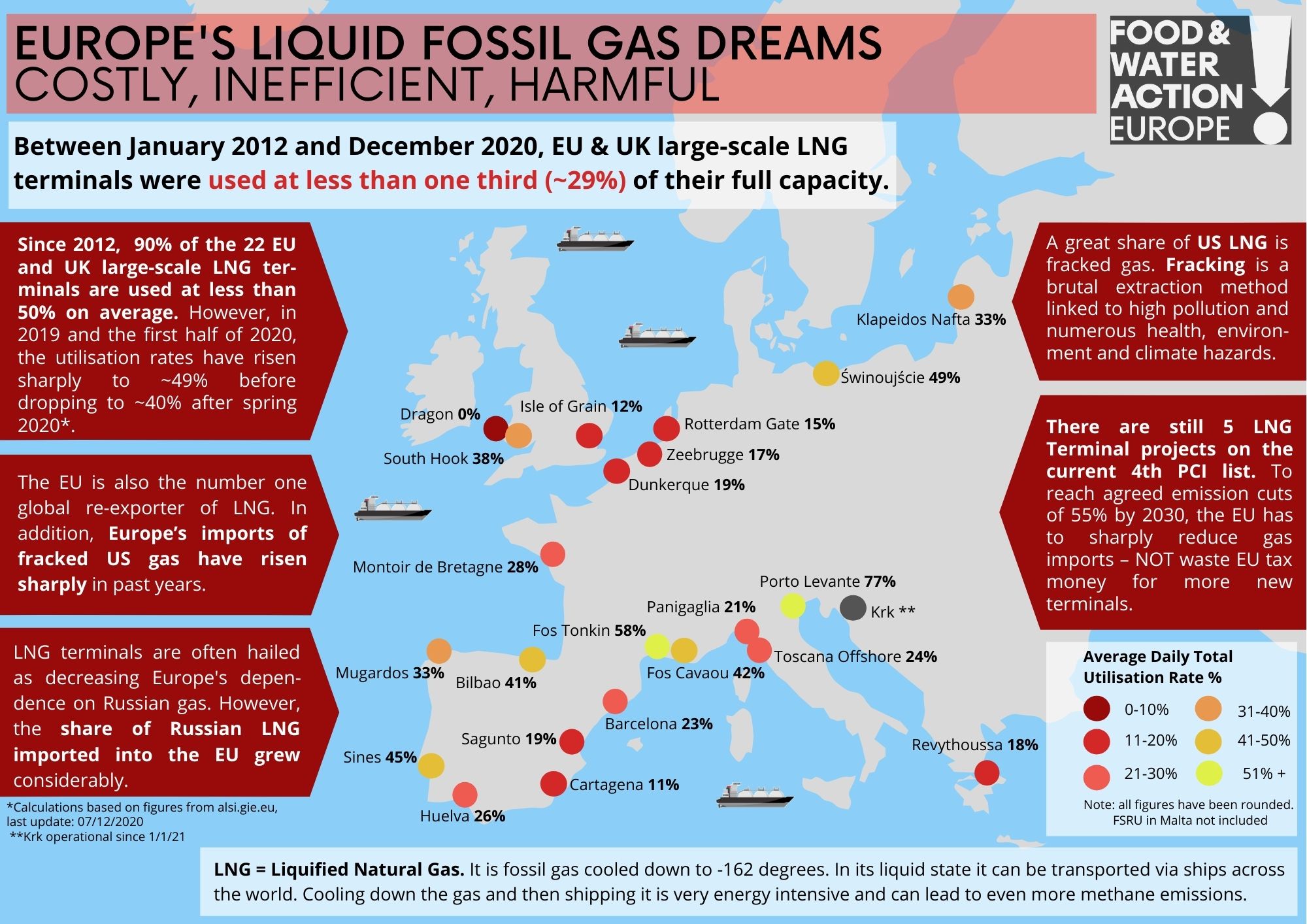The EU, the world’s biggest fossil gas importer, is bringing in a large amount of the dirty fuel in its liquid form – better known as LNG, or liquefied natural gas. LNG is fossil gas that has been cooled down to -162°C, so that it can be shipped across the world to then be turned back into its gaseous form. LNG is harmful for our climate and environment. Methane leaks all along the gas supply chain, and the process of cooling and shipping the fuel require a lot of energy and is also very polluting.
LNG is fossil gas that has been cooled down to -162°C, so that it can be shipped across the world to then be turned back into its gaseous form. LNG is harmful for our climate and environment. Methane leaks all along the gas supply chain, and the process of cooling and shipping the fuel require a lot of energy and is also very polluting.
The EU and UK count 23 operating large-scale LNG terminals* which have been largely underused: between January 2012 and December 2020, EU and UK LNG terminals have been operating at only 29% of their full capacity**. But there are plans to expand LNG import and storage capacity, and in the last two years, the EU and UK have considerably increased their LNG imports.
A significant drop of LNG prices, caused by shrinking Asian demand and the alignment of European prices with East-Asian ones, made the EU a competitive destination for the polluting liquefied fuel. The average LNG terminals utilisation rates rose to 47% in 2019 and reached 51% during the first half of 2020, before falling again to 40%, partly due to COVID-19 lockdown measures.
The EU is also a champion in LNG re-exporting, meaning it imports LNG from the US or elsewhere and then re-exports it to Asia, which leads to even more inefficiencies with energy wasted in transport. In 2019, France was re-exporting more LNG than any other country, and the Netherlands and Belgium came in 3rd and 4th position respectively.
LNG is Costly
In 2019, the cost of LNG imports in the EU amounted to €16,2 billion. Instead of importing climate-hostile energy via polluting ships from the other side of the word, this money could have been invested in renovation programmes or local renewable energy infrastructure.
LNG is Inefficient
Given the EU’s enthusiasm for LNG, it is appropriate to ask how increasing these imports would be compatible with the EU’s commitment to reduce our greenhouse gas emissions by 55% by 2030. Indeed, to respect that commitment, the European Commission estimates that the EU will have to reduce gas imports by 13-19% by 2030 compared to 2015. Yet the same Commission supports the build-out of gas infrastructure; Its priority project list (the PCI list) still contains 5 LNG import projects. Given that the existing LNG terminals are largely underused, and the need to reduce our LNG imports in the next 10 years, going forward on any of these projects would be highly irresponsible.
One of the declared aims of the EU Commission is to reduce the EU’s dependence on Russian gas. But while LNG terminals are hailed as enablers of this independence, the share of Russian LNG imported to Europe has actually grown more than LNG from most other destinations in the last two years; Russia is among the top 3 countries exporting LNG to Europe.
LNG is Harmful
In addition to the pollution created by LNG production and transport, the EU is increasingly supporting fracked gas production through growing LNG imports from the US. Particularly since mid-2018, the US is expanding its LNG exports linked to fracking, a brutal, water-intensive gas extraction method that creates earthquakes, leads to considerable methane emissions and the release of chemicals into the air and water, putting the environment and affected communities at risk. Fracking has outraged people across the continent, and some European countries, like France, have banned fracking extractions and cancelled fracked gas imports. More countries and a full EU-wide ban on fracking and the import of fracked LNG need to follow.
—
* With the 23rd terminal, Krk LNG, only starting to operate on 1 January 2021, numbers apply to 22 terminals only.
**Percentage of the average aggregated gas flow out of the LNG facility compared to the total send-out capacity. Calculations are based on figures from alsi.gie.eu (last update: 07/12/2020).


